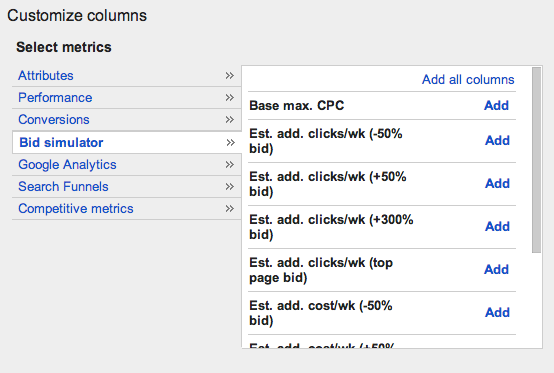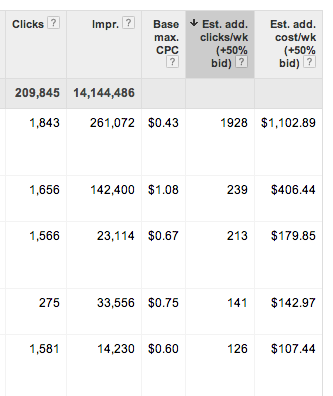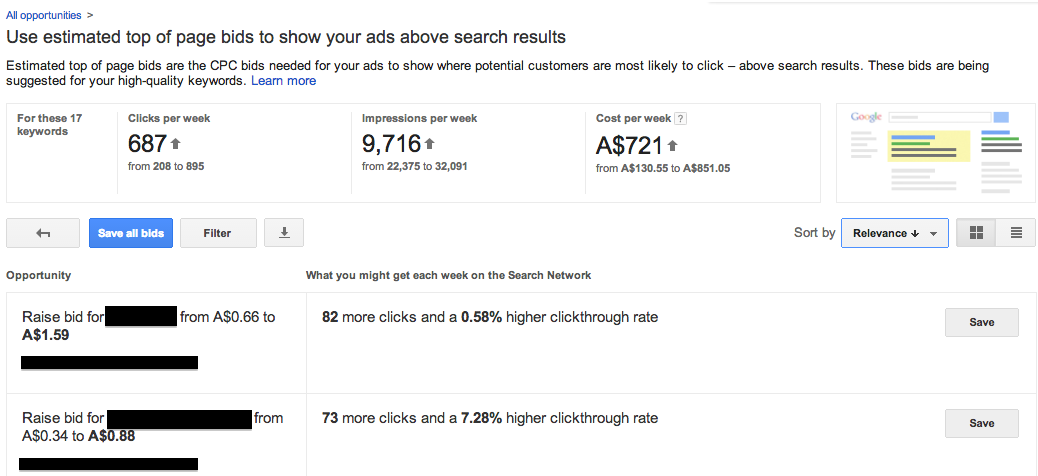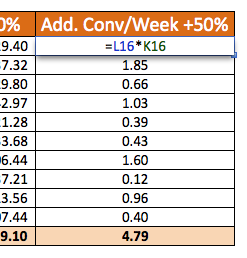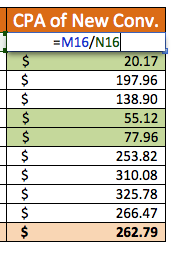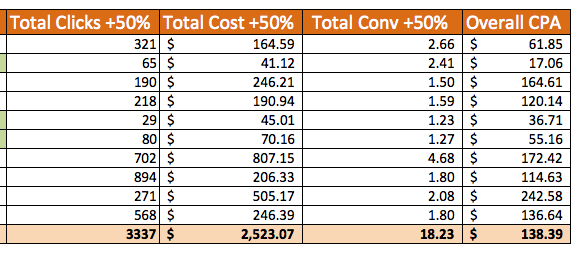Earlier last week AdWords announced on Google+ that they had launched a shiny set of new columns for our keyword report tabs. These columns are designed to give us quick access to the bid simulator data that was previously only available on a keyword by keyword basis. Google is providing data to show what would happen at plus or minus 50%, plus or minus 300% and at top of page bids (pos. 1-3).
To find the new bid simulator columns go into your keywords tab and then select Columns > Bid Simulator:
Once you’ve added your columns you’ll see something that looks like the following:
Base max CPC is slightly confusingly just your current CPC bid – I’m guessing AdWords included it as a column just to remind users that the basis of +50% is their current bid, not their current actual CPC.
Why is this better than what we currently have?
At the moment there are two ways to get simulated bid results from AdWords. The first is that little box that sometimes shows up next to your keywords. This is the way I check to see how many extra clicks and top impressions my keywords could get. However, it is really only designed to be used on an ad hoc basis with your most important keywords.
The second way is from the “Opportunities” tab shown below. The trouble with this is that it doesn’t give us the information we need to actually decide if a keyword is worth bidding up, namely conversion rate and cost per conversion. In the first example I might not want to get 82 more clicks from a keyword that has a high historical cost per conversion.
Benefits of the new columns
Using the new columns allows me to pull my data into Excel, which is where the real magic happens. I’m going to walk through how I use these columns to help me decide on two things:
- If any of my keywords would benefit from a 50% bid increase
- What the impact on my overall CPA and conversion volume would be from a 50% bid increase
In this example I’ve downloaded data for 10 important keywords in an account. You might need to do a little bit of work to get your cost, clicks and conversions into the same number of days as the estimated additional clicks and cost. In this case I’m going with 7 days:
From here I’m going to add on my first calculated column, “Additional Conversions Per Week at +50% bids.” I get this by multiplying my additional clicks with my historical conversion rate. The wily amongst you will notice that I’m making one major assumption – that conversion rate is unaffected by average position. It’s generally close enough for me to trust this approach but there are a small number of cases where position and conversion rate are correlated.
I now want another column that calculates the cost per conversion (CPA) of my additional conversions (additional cost / additional conversions).
Notice I’ve highlighted some of these in green. These are keywords where the additional cost per conversion is below my target and therefore I should raise my bids to get extra conversions.
This data is interesting, but what I really want to know is what the 50% change will do to my overall numbers. To do this you have to create even more columns! For these totals I’ve added the original clicks, cost and conversions per week to the estimated numbers with the bid increase. Overall CPA is total cost divided by the total conversions.
Finally, for the sake of clarity I’m going to pull the totals that I care about into a table. This helps me make a mental picture of the results of a 50% bid increase:
So how do we use this data? I now have a decision to make. I know I can get an extra 4.8 conversions per week by increasing my bids 50%, but I also know it will cause my overall CPA to hit $138. Therefore, it all depends on my goals. If I’m looking at growing my business and $138 CPA is acceptable, increasing bids 50% seems like a good call. If CPA is hugely important, I know that the cost to get these extra conversions is too high.
What are the limitations?
This is still a limited tool. I mean, who wants to know the impact of a 300% bid increase? Even 50% is a little high for my tastes as I cap at plus or minus 25% per round of bid changes. Top of page bid estimate is the most useful, but chances are that most of my best keywords are already showing in at least position three. Were AdWords to ever introduce a “First Place” estimate, I would get a little more excited.
However, the tool does have its uses. I can show the impact of wide ranging bid changes to my clients quickly. It helps me paint a picture of how many extra clicks we could potentially bring in, and the increased costs of doing so (or vice versa if saving money is important). This isn’t a game changer for AdWords bidding – I’m hoping that a fully customizable bid simulator will come one day – but it is a useful addition to our PPC toolkit.
How do you currently simulate bid changes? Will this new set of columns help you or is it a waste of time? Let us know in the comments below!



